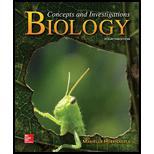
What is the difference between a macronutrient and a micronutrient?
- a. The size of the atoms
- b. The amount required by the plant
- c. The use by multicellular organisms (macroorganisms) versus microorganisms
- d. The source of the nutrient
Introduction:
Every living organism like plants, humans and animals, all require essential nutrients which are chemical substances important for metabolic reactions, growth, development and reproduction. There are two types of nutrients: micronutrients and macronutrients.
Answer to Problem 1MCQ
Correct answer:
Macronutrients are those nutrients which are required in large amounts and micronutrients are those which required in small amounts. There are total 9 macronutrients like carbon, oxygen, hydrogen, nitrogen are some of them. There are 7 micronutrients. Chlorine, iron, boron and zinc are some of them. Therefore option (b) is the correct answer.
Explanation of Solution
Reason for the correct statement:
The amount of nutrients required by plants is the basis of differences between macro and micronutrients. The nutrients needed in large amounts by the plants are macronutrients and those required in smaller quantity are micronutrients.
Option (b) is given as “the amount required by the plant”.
As, “amount required by the plant is the basis of difference between a macronutrient and a micronutrient”, is the right answer.
Hence option (b) is correct.
Reasons for the incorrect statements:
Option (a), is given as “the size of the atoms”.
The abundance or quantity of nutrients by the organisms forms the basis of difference between micro and macronutrients and not the size of the atom. Hence, it is a wrong answer.
Option (c), is given as “the use by multicellular organisms (microorganisms) versus microorganisms”.
Micro and macronutrients are used by all the organisms whether they are multicellular or microorganisms and therefore it is not the basis for the difference between micro and macronutrients. Hence, it is a wrong answer.
Option (d), is given as “the source of the nutrient”.
A single source may contain either both micro and macronutrients or may contain only one type of nutrient. Thus, source of nutrient does not make the basis for the difference between micro and macronutrients. Hence, it is a wrong answer.
Hence options (a), (c), and (d), are incorrect.
Macronutrients are those nutrients which are required in large amounts and micronutrients are those which are required in small quantities by the plants.
Want to see more full solutions like this?
Chapter 23 Solutions
Biology: Concepts and Investigations
- Noggin mutation: The mouse, one of the phenotypic consequences of Noggin mutationis mispatterning of the spinal cord, in the posterior region of the mouse embryo, suchthat in the hindlimb region the more ventral fates are lost, and the dorsal Pax3 domain isexpanded. (this experiment is not in the lectures).a. Hypothesis for why: What would be your hypothesis for why the ventral fatesare lost and dorsal fates expanded? Include in your answer the words notochord,BMP, SHH and either (or both of) surface ectoderm or lateral plate mesodermarrow_forwardNot part of a graded assignment, from a past midtermarrow_forwardNot part of a graded assignment, from a past midtermarrow_forward
- please helparrow_forwardWhat does the heavy dark line along collecting duct tell us about water reabsorption in this individual at this time? What does the heavy dark line along collecting duct tell us about ADH secretion in this individual at this time?arrow_forwardBiology grade 10 study guidearrow_forward
 Concepts of BiologyBiologyISBN:9781938168116Author:Samantha Fowler, Rebecca Roush, James WisePublisher:OpenStax College
Concepts of BiologyBiologyISBN:9781938168116Author:Samantha Fowler, Rebecca Roush, James WisePublisher:OpenStax College Biology (MindTap Course List)BiologyISBN:9781337392938Author:Eldra Solomon, Charles Martin, Diana W. Martin, Linda R. BergPublisher:Cengage Learning
Biology (MindTap Course List)BiologyISBN:9781337392938Author:Eldra Solomon, Charles Martin, Diana W. Martin, Linda R. BergPublisher:Cengage Learning Biology Today and Tomorrow without Physiology (Mi...BiologyISBN:9781305117396Author:Cecie Starr, Christine Evers, Lisa StarrPublisher:Cengage Learning
Biology Today and Tomorrow without Physiology (Mi...BiologyISBN:9781305117396Author:Cecie Starr, Christine Evers, Lisa StarrPublisher:Cengage Learning





